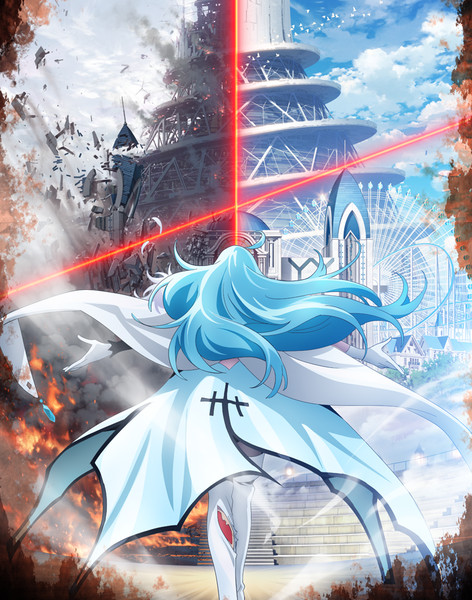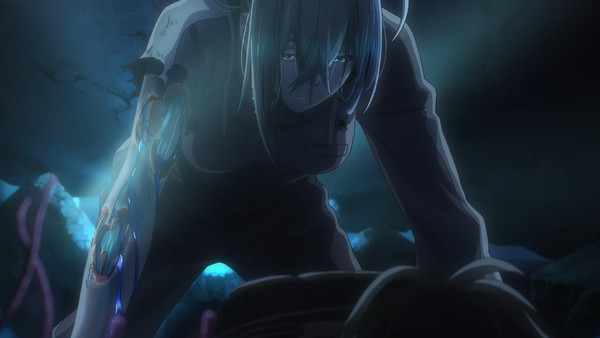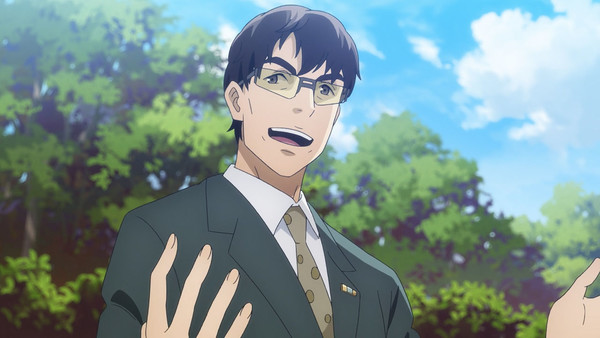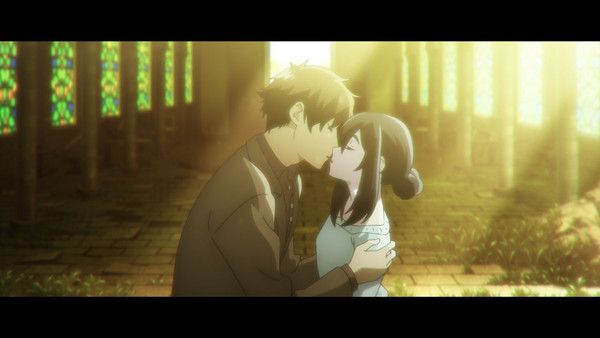Exploring the "Concept" Novel of Vivy -Fluorite Eye's Song-
by Kim Morrissy,Making an original anime is tough. Coming up with a cool idea and securing the funding for it is only the first part of an uphill battle – you still have to communicate that idea to the staff. And when you're making something from nothing, you can't just a plop a manga or a novel on people's desks and say, "Read this. This is what we're doing."
...But what if you could do just that?

Vivy -Fluorite Eye's Song- is the work of light novel author Tappei Nagatsuki (Re:Zero) and visual novel writer Eiji Umehara (Chaos;Child). It's an original anime, but it's also kind of sort of based on a novel. At the very beginning of the project, the screenwriters teamed up to write a "concept" novel that the anime would pull ideas from.h7jI6X877k
As Umehara explained in an interview posted on the anime's official website:
I worked on the screenplay for Re:ZERO -Starting Life in Another World- (Re:Zero), an animated TV series based on Mr. Nagatsuki's novels, and the screenplay meetings for that show were really great experiences for me. I learned a lot about how to adapt a novel into an animated TV series and was able to have constructive discussions with the original novelist, Mr. Nagatsuki. Since that was the first time I worked on series composition for an animated TV series, I wanted to incorporate techniques that were successful with past titles that I had worked on. So for Vivy, I first wanted to have a novel written before we worked on the screenplay.
A total of four novels were written, separated into the major story arcs, with Nagatsuki and Umehara alternating between volumes. Together, they had roughly planned out how long each arc would take in anime form, but when it came to writing the novels, they had no length restraints. The idea was to convey everything they had in their minds through prose, the art craft they knew best.
Inevitably as a result of this approach, the story was heavily edited when they started working on the anime in earnest. According to Nagatsuki, "the characters' personalities, the events of the story, and even the narrative arc that leads to the ending are different."
This claim piqued my attention, so I read the first two volumes of the Vivy Prototype novels to experience it all for myself.
Note: This article will contain spoilers for the first seven episodes of Vivy -Fluorite Eye's Song-.

In the story of Vivy, the titular protagonist is tasked with preventing the robot apocalypse over the course of 100 years by changing history at distinct points of time. The plot of the first Vivy Prototype novel roughly corresponds to the first four episodes of the anime, which cover Vivy's first two objectives, spaced 15 years apart.
The interesting thing about the novel isn't simply that the details are different, but that these details strongly shaped how I perceived the characters, their motives, and even the themes of the story. I'm going to list the biggest differences that stood out to me and explain their significance:
Three Laws vs One Mission
Isaac Asimov's Three Laws of Robotics are a common staple of science fiction, and the Vivy Prototype novel is no different in this regard. To quickly recap the three laws as they apply to Vivy:
- A robot may not injure a human being.
- A robot must obey the orders given by their owner except where such orders would conflict with the First Law.
- A robot must protect its own existence as long as such protection does not conflict with the First or Second Law.
There is also the Zeroth Law: A robot must act in the good interests of humanity.
These four principles are used to explain the actions of the AI characters. Matsumoto, for instance, is all on board with incapacitating people and other punitive measures because he's aware of the future and is acting under the Zeroth Law. It's also why he prevents Vivy from saving Momoka, because changing history any further than what is deemed necessary could have catastrophic effects on humanity.

As its own twist on the familiar robot tropes, the AI in this series are also guided by "missions." You can think of them as a priority or an imperative that influences decision-making. AI will always prioritize actions that will contribute to their mission, which in most cases is serving humans.
In the anime, the Laws of Robotics aren't explicitly mentioned, so you're just left with the missions as the rationale for character actions. For example, it's Vivy's mission to make everyone happy through singing to them. Whenever she's asked to explain her actions, no matter how baffling or contradictory they appear to be on the surface, that's the explanation she provides.
This leads directly into the biggest difference between the novel and anime in the narrative's first act:
Vivy's Starting Line

One of the most memorable scenes in episode 2 is when Vivy uses her body to protect the young anti-AI terrorist Kakitani from falling debris. She had absolutely no reason to save someone who was trying to kill her or Aikawa, the politician she's trying to protect. Yet she does it anyway, claiming that it's all for the sake of her "mission."
In the novel, this choice never comes up to begin with. In the climax of the chapter, Kakitani gets into a trailer and attempts to run over Aikawa just as he's about to get away. Instead of saving Kakitani, Vivy uses her body to protect Aikawa. Kakitani can only watch with rage as the two make their getaway.
The opening arc has other little differences between the novel and anime: for example, Vivy is already popular as a performer in the novel, while in the anime Momoka was her only fan. Also, Vivy's first encounter with Aikawa is through the terrorist attack on the data center, and the scene where she tries to prevent a bomb attack at NiaLand doesn't happen at all.

In the context of an anime, which emphasizes visual storytelling, it's easy enough to piece together the reasoning behind the differences: it's to make a point about how much Vivy has to grow, both as a songstress and in her working relationship with Matsumoto.
Vivy's distrust of Matsumoto is obvious from their first meeting. It's so obvious in the anime, in fact, that it's the bomb scare at NiaLand that ultimately convinces her to take his claims seriously. Saving Kakitani can also be seen as a point of tension between the two AI, as Matsumoto exasperatedly criticizes Vivy's seemingly illogical actions.
The novel and anime ultimately end in the same place, with Vivy fighting futilely against Matsumoto in her desperation to save Momoka. In that moment, Matsumoto reminds her of the duty to serve all of humankind, rather than individuals. It's a stark scene that affirms the individuality of AI and also the vagueness of their directives. You could say that this moment is the "starting line" for Vivy's 100-year journey with the evolution of AI.
Nevertheless, by emphasizing Vivy's fallibility even before this moment, the anime sets up a stronger contrast with later events.
The Sunrise Mystery

Despite the obvious strengths of animation as a visual medium, novels are able to go into more detail about the characters and setting, and those differences are evident in Vivy Prototype as well. Notably, a large chunk of the novel is concerned with a subplot that was only passingly mentioned in the anime: the mystery of what happened to the previous owner of the Sunrise space hotel, Ash Corvick.
Broadly speaking, Vivy's second arc can be divided into two parts: a mystery part where Vivy investigates Estella's background, and a more action-oriented part focusing on Elizabeth and the terrorists. On a narrative level, the suspicion around Estella serves as a red herring to prompt the reader to let their guard down, but it also serves to develop the role of AI and their relationship with humans.
In the novel, Estella doesn't become the owner of the hotel. Instead, it's Ash's brother Arnold, who leans on Estella for support. While Ash was described as a fearless and adventurous spirit, Arnold was sickly and lacked business skills. Although he technically stood to benefit the most from Ash's death, prompting conspiracy theories among the public, for many years both he and Estella believed that it was a suicide.
The truth of the incident is the same as what is mentioned in the anime: it really was an accident. Tragically, Ash wanted Estella to become a songstress like her older sister model Diva (i.e. Vivy), but didn't have the chance to tell her that. So unlike the anime, where Estella is shown regularly singing to guests to soothe them, she only begins singing due to the events of the story.
Perhaps the tragedy of Estella's character in the novel is that she didn't live up to her full potential as an AI until the very end. Of course, in both versions of the story, it was in her final actions that she changed the course of the future.
Plot Divergences in Volume 2

The second volume is covered in episodes 5 and 6, and it's here that we see the story and characters really begin to diverge from the anime. The most striking difference is in Vivy herself. In the novels, her consciousness as "Vivy" goes to sleep between the Singularity points, leaving her "Diva" persona to continue her ordinary routine. The contrast between "Vivy" and "Diva" becomes a plot point in volume 2, when "Diva" asserts her own presence at crucial intervals.
To briefly recap the plot of Vivy's third arc, a researcher named Saeki proposed to his AI nurse Grace, but they are torn apart when Grace is assigned to be the mother computer of Metal Float. In the novel, it is Diva who sees Grace off at the time, saying that it is an AI's duty to fulfill their mission no matter what it is.
"Even if the world were to be embroiled in war, even if it resulted in the deaths of many people... if there was even one member of my audience left, I would continue singing for them. For just one person, I would get on the stage. That is the mission of who I am right now. And if I were given the mission to go out into the battlefield and save lives, then I would leave the stage even if the audience stand was full."
After Vivy destroys Grace, the novel features an aftermath chapter, which delves further into the relationship between the Vivy and Diva personas. In this chapter, Diva becomes aware that there is a separate personality of hers that has been taking control of her body at certain points in time. At first, she is hostile towards this fact, regarding it as a bug, but after an encounter with Saeki, she changes her mind. Saeki says that although he was angry at first about losing Grace, he understands why Vivy did what she did. Although Diva never grasps the full context, she does understand vaguely that Vivy was fulfilling a mission, as an AI should.

Diva's meeting with Saeki in the novel takes place 37 years after the events of the third arc. As it turns out, Saeki lived a long life and eventually made peace with what happened. In the anime, however, there is no time skip. Saeki meets Vivy in the church where he and Grace were supposed to get married in a different timeline. He says that he associates Grace with Vivy's song, and then shoots himself in front of Vivy. It's a cruel twist which drives Vivy into a corner, making her realize for the first time that maybe her song can't make people happy. A confounding dilemma indeed for an AI who has been tasked with making people happy through singing to them.
In the novel, Diva grapples with this dilemma in her own way. The realization that perhaps the bug in her (i.e. Vivy) could prevent her from fulfilling her duty makes her temporarily freeze up on stage, unable to perform. Before she meets Saeki, she encounters a shopkeeper who tells her how much he hates her because his father's obsession with her ruined his life. She's also compared with a human idol, and worries that because she's an AI she can't reinvent herself or "work hard" like a human can.
At the end of the chapter, Diva is comforted by the human idol who should have been her rival. The idol, as it turns out, was a fan of her all along. And Diva also receives a short message from Vivy: "Stop worrying about unnecessary things and put your heart into singing as usual."
In complete contrast to the anime, the novel portrays a sweet and mellow conclusion to a grim storyline. An AI's mission might bring them to do heartbreaking things, but it's a life lived without regrets – that message comes across loud and clear.
The implications of Vivy and Diva having separate personas, rather than existing as part of the same consciousness, comes up in the anime starting from the fourth arc in episode 7. In the anime, the division is caused by Vivy's mental strain after Saeki's suicide. So to see it established earlier in the novels in a very different way hints at further divergences down the line.

Overall Thoughts
The relationship between the "concept novel" and anime is rather complicated, as you can see. The plot differences are significant, but you can also see them as complementing each other's themes. It's hard to pick one and say, "This is the superior telling of the story."
This is honestly the kind of relationship I wish to see more often between anime and their source material. It's industry common sense to try to keep the anime as close to the original story as possible, making minor adjustments to suit the medium, but that also means that all too often anime adaptations feel like half-hearted copies. At the same time, it feels like this kind of ideal arrangement was only possible because there was no expectation to be faithful to a concept novel, and because the original writers wrote the anime screenplay as well.
Vivy is by no means a revolutionary story – its strength is more in its sentimental drama than in its retreading of familiar sci-fi tropes – but it deserves to be remembered as a successful original anime. As Umehara said, the only downside to their writing approach was that it took extra time to complete the work. Alas, time is a scarce resource in the grueling schedules of the modern anime industry, and that's all the more reason we should treasure every anime like Vivy. You might not see anything quite like it in another 100 years.
ies no ies uudiscuss this in the forum (7 posts) |